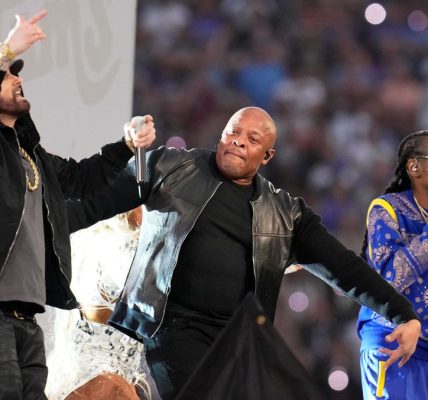David Bowie was a true innovator, consistently defying the status quo throughout his illustrious career. If one could encapsulate his approach to music and life, it might simply be summarized as “be yourself,” a mantra that resonated deeply with him. This philosophy was particularly evident during the vibrant and transformative 1980s, a decade in which Bowie had amassed considerable experience and had reached a fulfilling point in his personal and professional life.
Reflecting on this period, he expressed to writer Gary Graff in 1987 (as reported by Billboard), “I’m much happier than I was in my early 20s. At that time, I always felt I should have been older. I’ve caught up with myself, really.” This newfound contentment allowed him to explore his artistic boundaries with confidence.
While Bowie’s output in the 1970s is often hailed as his most groundbreaking and influential, it was during the 1980s that he achieved unprecedented commercial success. He hit his stride and was acutely aware of his capabilities. “I don’t find it a problem to use the techniques and styles I’ve used before, where at one time I thought, ‘I can’t do that!'” he shared with Graff. “I was very into making the Big Artistic Statement — it had to be innovative and cutting edge. Now I’m not trying so obsessively to be up against the sky. It’s almost like I’m a style — a David Bowie Sound!“
There is a wealth of material to appreciate in Bowie’s extensive 1980s catalog. Below, we’ve curated a list of 15 of the finest tracks from this era, presented in chronological order for your exploration.
1. “Ashes to Ashes”
From: Scary Monsters (and Super Creeps) (1980)
While Bowie rarely looked back, he revisited the iconic character of Major Tom in 1980’s “Ashes to Ashes,” symbolically closing the chapter on the 1970s. Interestingly, that’s Roy Bittan from Bruce Springsteen’s E Street Band contributing his talents on a flanged piano for this track. Only Bowie could craft a hit song that delves into themes of corruption, drugs, space, and the loss of innocence with such artistry.
2. “Fashion”
From: Scary Monsters (and Super Creeps) (1980)
Another standout from the 1980 album Scary Monsters (and Super Creeps) is “Fashion,” featuring the legendary Robert Fripp of King Crimson on lead guitar. Bowie, known for his bold fashion choices and experimentation with clothing and makeup throughout the 1970s, began to perceive fashion in the 1980s as overly contrived. He noted, “When I first started going to discos in New York in the early ’70s, there was a natural enthusiasm that seems to have been replaced by a grim determination to be fashionable.” He aimed to encapsulate this sentiment in “Fashion,” highlighting that relentless drive to conform.
3. “Under Pressure” With Queen
From: October 1981 Single
Imagine a world where “Under Pressure” was solely performed by Queen or exclusively by Bowie. The synergy created by their collaboration is undeniable, leading to a song that not only topped the charts but also featured one of the most recognizable bass lines in music history. However, the creative process was not without its challenges. Brian May of Queen shared with Guitar World in 2024, “I never liked it, to be honest, the way it was mixed, but I recognize that it works. It’s a point of view, and it’s done very well.” The enduring popularity of this collaboration speaks to their combined talent.
4. “Modern Love”
From: Let’s Dance (1983)
As the 1970s transitioned into the 1980s, the New Wave genre began to emerge, and Bowie dabbled in this fresh sound. “Modern Love” exemplifies this blend, incorporating elements of rock, soul, and funk. The track features contributions from Stevie Ray Vaughan and Nile Rodgers of Chic. Rodgers remarked in a 2016 interview with Rolling Stone, “He was compelled to do things that he felt were just the right thing to do.” Bowie’s instinctive approach is encapsulated in the lyrics: “I know when to go out, know when to stay in, get things done.”
5. “Let’s Dance”
From: Let’s Dance (1983)
Despite its massive popularity, Bowie expressed mixed feelings about the implications of “Let’s Dance” on his artistic identity. In a 1995 interview with Interview magazine, he stated, “I went mainstream in a major way with ‘Let’s Dance.’ I pandered to that in my next few albums, and I found I had put a box around myself. It was difficult for people to see me as anything beyond the person in the suit who performed ‘Let’s Dance,’ and it drove me mad because it stripped the passion for experimentation away.” Nevertheless, its infectious catchiness and the fact that it achieved No. 1 status in both the U.K. and U.S. is undeniable.
6. “China Girl”
From: Let’s Dance (1983)
In 1983, Bowie released a popular rendition of “China Girl,” which he co-wrote with Iggy Pop in 1976. While Pop’s version appeared on his 1977 album The Idiot, Bowie’s iteration became the definitive version, characterized by a more commercial pop sound and highlighted by Carmine Rojas‘ prominent bass line. The song also features a stunning guitar solo by Vaughan. Engineer Bob Clearmountain recounted that Vaughan only heard “China Girl” once before laying down his impressive solo. Bowie appreciated the rawness and spontaneity of the first take, famously saying, “It’s perfect,” showcasing his love for dissonance and authenticity.
7. “White Light/White Heat” Live (by the Velvet Underground)
From: Ziggy Stardust: The Motion Picture (1983)
From the moment Bowie discovered the music of the Velvet Underground, he felt a deep connection with Lou Reed. Reflecting in 1997, Bowie mentioned, “I don’t think I ever felt that I was in a position to become a Velvet’s clone, but elements of what Lou was doing felt unavoidably right for both the times and for where music was going.” Bowie recorded a live interpretation of “White Light/White Heat” in London in 1973, but it wasn’t released until 1983, proving that some artistic expressions are indeed worth the wait.
8. “Blue Jean”
From: Tonight (1984)
Bowie had an exceptional talent for crafting sultry verses that seamlessly transitioned into bold, catchy choruses, and “Blue Jean” is a quintessential example. The song draws inspiration from 1960s psychedelic pop, English beat, and traditional rockabilly, which contributed to its appeal across both American and British audiences. Bowie himself noted to NME in 1984 that the song was inspired by the essence of Eddie Cochran, blending influences that made it uniquely eclectic. He mused, “What of mine isn’t?”
9. “Tonight” With Tina Turner
From: Tonight (1984)
It’s noteworthy that Peter Frampton credited Bowie with significantly impacting his career revival, and Tina Turner felt similarly grateful. Turner collaborated with Bowie on the title track of the 1984 album Tonight. In 1983, both artists were signed to Capitol Records, but the label did not extend a contract to Turner. She later recounted that Bowie declined a dinner invitation from Capitol executives, opting instead to see her perform, which helped secure her another record deal. “It was because of David that I got another deal, and everything else followed,” Turner expressed, highlighting Bowie’s influence and support.
10. “This Is Not America”
From: February 1985 Single
This list inadvertently features many collaborations, showcasing Bowie’s adventurous spirit in the 1980s. One such collaboration is the often-underappreciated “This Is Not America,” which he recorded with renowned jazz guitarist and composer Pat Metheny. Metheny reminisced after Bowie’s passing in 2016, saying, “Watching him perform his vocal was something I will never forget. It was masterful, akin to being around a great jazz musician whose unique presence filled every note.” Bowie demonstrated his versatility by performing all the background vocals himself, transforming into multiple personas to deliver each part.
11. “Dancing in the Street” With Mick Jagger
From: August 1985 Single
Many artists have attempted to cover “Dancing in the Street,” but few could match the charisma of the iconic duo, Bowie and Mick Jagger. Initially, they planned to perform the song live at Live Aid with Jagger in Philadelphia and Bowie in London, but technical difficulties thwarted those plans. Instead, they recorded the track in a studio and shot a music video in just 13 hours. Their rendition not only topped the charts but also donated its proceeds to famine relief, highlighting their commitment to social causes.
12. “Absolute Beginners”
From: March 1986 Single
It’s a common misconception that featuring Bowie in a film guarantees box office success, as Julien Temple discovered with 1986’s Absolute Beginners. Despite the film’s lukewarm reception, Temple asked Bowie to contribute music, resulting in three songs: “Volare,” “That’s Motivation,” and the standout track “Absolute Beginners.” This last song exemplifies Bowie’s exceptional talent for arrangement and melody, proving his artistic prowess even in challenging circumstances.
13. “Magic Dance”
From: January 1987 Single
In the same year Bowie starred in Absolute Beginners, he also took on the role of Jareth, the Goblin King, in Labyrinth. Along with several songs for the film, “Magic Dance” became a fan favorite. During the recording, Bowie humorously attempted to get his backing singer, Diva Gray, to coax a baby into making gurgling sounds for the track. When that didn’t pan out, he cleverly decided to create the baby sounds himself, showcasing his whimsical and playful side, which remains underrated in his discography.
14. “New York’s in Love”
From: Never Let Me Down (1987)
Although 1987’s Never Let Me Down isn’t typically celebrated as one of Bowie’s strongest albums, it does contain hidden gems worth acknowledging. One such track is “New York’s in Love,” which Bowie described to Music & Sound Output (via bowiebible.com) as “a rather sarcastic song about New York.” Interestingly, just five years later, Bowie and his wife Iman would purchase their first home in the city and become long-term residents until Bowie’s passing, adding a layer of personal significance to the song.
15. “Time Will Crawl”
From: Never Let Me Down (1987)
Don’t let the bright-sounding introduction of “Time Will Crawl” mislead you; this track tackles serious themes of global pollution and apocalyptic imagery. Bowie consistently exhibited a fascination with the intersection of humanity, science, and the chaos that often ensues. The inspiration for this song stemmed from the catastrophic 1986 Chernobyl nuclear disaster, a theme that remains alarmingly relevant in today’s context.
Comprehensive Ranking of Every David Bowie Single
Join us as we reflect on all of David Bowie’s singles released during his lifetime — from the pre-Ziggy Stardust era through the Berlin Trilogy and into his late-career renaissance.
Gallery Credit: Nick DeRiso and Michael Gallucci






